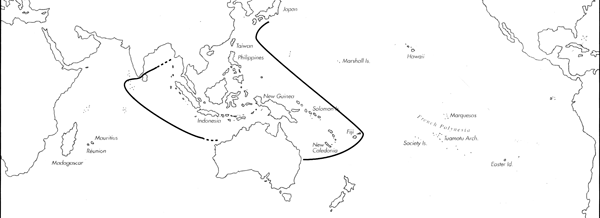Range: Central Indian Ocean (Sri Lanka, Maldives) to Marshall Is. and Fiji, Ryukyu Is. to W. and E. Australia.
Description: Small, light to moderately light. Last whorl conical or ventricosely conical to broadly ventricosely conical; outline faintly to distinctly convex at adapical half and usually straight below. Aperture may have a transverse ridge at centre. Shoulder angulate to occasionally rounded, weakly to distinctly tuberculate. Spire of low to moderate height, outline slightly concave to slightly convex. Teleoconch sutural ramps flat, in later whorls with 2 increasing to 3-4 spiral grooves. Last whorl with weak to distinct, granulose spiral ribs at base; sometimes extending to centre or even to shoulder.
| Shell Morphometry | ||
|---|---|---|
| L | 14-30 mm | |
| RW | 0.03-0.11 g/mm | |
| RD | 0.59-0.77 | |
| PMD | 0.78-0.93 | |
| RSH | 0.02-0.15 | |
Ground colour white to pale grey. Last whorl with a grey, orange or reddish brown spiral band on each side of centre; bands occasionally obsolete or fusing into a single basal colour zone. Spiral rows of brown dots and dashes extend from base to shoulder, varying in number and arrangement. Dark dots may alternate with white dashes or dots. Base and basal part of columella dark bluish violet. Later sutural ramps crossed by brown markings between shoulder tubercles. Aperture pale violet to dark bluish violet, usually with a ground-colour band at centre and below shoulder.
Periostracum light brown, thin, variably translucent, and smooth.
Form mighelsi (Pl. 8, Figs. 12, 18) characterized by a broad pinkish red to orangish red spiral band above centre. Form ceylanensis (Pl. 8, Figs. 10, 11, 19, 20) characterized by variously coalescing brown to reddish brown axial blotches or wavy flames on central area of last whorl, occasionally interrupted by a narrow ground-colour band in the middle; spiral rows of brown dots or dashes restricted to adapical and abapical parts of last whorl. Dorsum of foot white to red at its extremities; latero-marginal zones similar to median area or contrasting in colour pattern (red, often with white axially elongate markings), occasionally separated from median area by a dark groove; anterior part sometimes with a black central spot and white dots at corners; area below operculum sometimes white. Sole of foot red, heavily maculated with white dots or oblong white markings, usually solid red at extremities; median area usually with a grey longitudinal line, sometimes only darker red. Rostrum red, sometimes mottled with white. Tentacles white to red with white eyestalks. Siphon pink with red dots or axial oblong white markings; white dots and thin brown lines may also be present; tip of siphon usually red (Pl. 74, Fig. 13) (Chaberman, pers. comm., 1981; Pearson, unpubl. observ.; Kohn, unpubl. observ.).
Radular teeth with an adapical barb opposite a blade; serration, centered waist and basal spur present (Nybakken, 1990, as C. ceylanensis).
Habitat and Habits: In 1-18 m, living on rock benches, subtidal reef flats, the reef rim and on lagoon pinnacles. Mostly found on sand-binding algal mats, limestone pavement, dead coral rocks or heads and in crevices of rocks or coral reefs. Somewhat more common in subtidal habitats (Cernohorsky, 1964; Kohn, 1968b; Kohn & Nybakken, 1975; Leviten & Kohn, 1980; Reichelt & Kohn, 1985; Tucker, 1973). C. musicus feeds on polychaetes of the families Nereidae and Eunicidae, primarily the former (Kohn, 1968 c; Kohn & Nybakken, 1975; Reichelt & Kohn, 1985).
Discussion: C. musicus resembles C. sponsalis in the characters of shell and animal. The latter species has larger size and a broader last whorl and less angulate shoulder. The colour pattern of typical C. sponsalis lacks dotted spiral lines; only form nanus sometimes bears sparse spirally arrayed dots, but not the more pronounced, darker dotting of C. musicus. The markings between the tubercles in C. musicus are blackish brown in most shells; they are lighter, usually reddish brown and less regular in C. sponsalis. The pronounced double row of red-brown axial flames in C. sponsalis is absent in C. musicus, including form ceylanensis, but it is also absent in C. sponsalis form nanus. The form mighelsi occurs predominantly in the Pacific. C. acutus represents a variant of typical C. musicus. Form ceylanensis occurs from Sri Lanka to W.Thailand, sympatric with the typical form and intergrading with it in colour pattern and shape. We cannot separate the two forms by shell morphometry. These data do not support separation of form ceylanensis from typical C. musicus at the species or subspecies levels.

C. musicus Range Map
This section contains verbatim reproductions of the accounts of 316 species of Conus from the Indo-Pacific region, from Manual of the Living Conidae, by Röckel, Korn and Kohn (1995). They are reproduced with the kind permission of the present publisher, Conchbooks.
All plates and figures referred to in the text are also in Röckel, Korn & Kohn, 1995. Manual of the Living Conidae Vol. 1: Indo-Pacific Region.
The range maps have been modified so that each species account has it own map, rather than one map that showed the ranges of several species in the original work. This was necessary because each species account is on a separate page on the website and not confined to the order of accounts in the book.